Related Research Articles

The Cuban Revolution was a military and political effort to overthrow the government of Cuba between 1953 and 1959. It began after the 1952 Cuban coup d'état which placed Fulgencio Batista as head of state and the failed mass strike in opposition that followed. After failing to contest Batista in court, Fidel Castro organized an armed attack on the Cuban military's Moncada Barracks on July 26th, 1953. The rebels were arrested and while in prison formed the 26th of July Movement. After gaining amnesty the M-26-7 rebels organized an expedition from Mexico on the Granma yacht to invade Cuba. In the following years the M-26-7 rebel army would slowly defeat the Cuban army in the countryside, while its urban wing would engage in sabotage and rebel army recruitment. Over time the originally critical and ambivalent Popular Socialist Party would come to support the 26th of July Movement in late 1958. By the time the rebels were to oust Batista the revolution was being driven by the Popular Socialist Party, 26th of July Movement, and the Directorio Revolucionario Estudiantil.
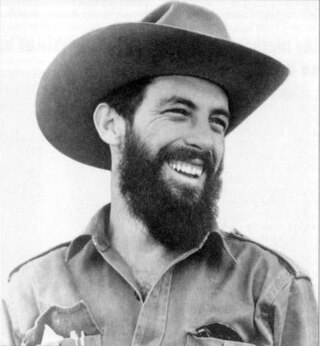
Camilo Cienfuegos Gorriarán was a Cuban revolutionary born in Havana. Along with Che Guevara, Fidel Castro, Juan Almeida Bosque, and Raúl Castro, he was a member of the 1956 Granma expedition, which launched Fidel Castro's armed insurgency against the government of Cuban dictator Fulgencio Batista. He became one of Castro's top guerrilla commanders, known as the "Hero of Yaguajay" after winning a key battle of the Cuban Revolution. His signature weapons were a M1921AC Thompson and a modified M2 carbine.

Jorge Castañeda Gutman is a Mexican politician and academic who served as Secretary of Foreign Affairs (2000–2003).

Alberto Granado Jiménez was an Argentine–Cuban biochemist, doctor, writer, and scientist. He was also the youthful friend and traveling companion of Che Guevara during their 1952 motorcycle tour in Latin America. Granado later founded the University of Santiago de Cuba School of Medicine. He authored the memoir Traveling with Che Guevara: The Making of a Revolutionary, which served as a reference for the 2004 film The Motorcycle Diaries, in which he was played by Rodrigo de la Serna. An elderly Alberto Granado makes a short appearance at the end of the film.

Celia Sánchez Manduley was a Cuban revolutionary, politician, researcher and archivist. She was a key member of the Cuban Revolution and a close colleague of Fidel Castro.

Michael Löwy is a French-Brazilian Marxist sociologist and philosopher. He is emeritus research director in social sciences at the CNRS and lectures at the École des hautes études en sciences sociales. Author of books on Karl Marx, Che Guevara, Liberation Theology, György Lukács, Walter Benjamin, Lucien Goldmann and Franz Kafka, he received the CNRS Silver Medal in 1994.

Richard Willoughby Gott, is a British journalist and historian. A former Latin America correspondent and features editor for the British newspaper The Guardian, he is known for his radical politics and a connection to Che Guevara. Gott resigned from The Guardian in 1994, after senior KGB defector Oleg Gordievsky accused him of having been a Soviet "agent of influence", a tag Gott at the time denied.

Armando Enrique Hart Dávalos was a Cuban politician and a Communist leader. His grandfather was born in Georgia, USA and emigrated to Cuba as a child.
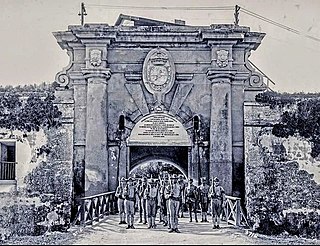
Fortaleza de San Carlos de la Cabaña, colloquially known as La Cabaña, is an 18th-century fortress complex, the third-largest in the Americas, located on the elevated eastern side of the harbor entrance in Havana, Cuba. The fort rises above the 60-meter (200 ft) hilltop, along with Morro Castle. The fort is part of the Old Havana World Heritage Site which was created in 1982.
Jorge Valls Arango was a Cuban activist and poet of who spent more than two decades in prison for his opposition to Fidel Castro.
Sandinista ideology or Sandinismo is a series of political and economic philosophies instituted by the Nicaraguan Sandinista National Liberation Front throughout the late twentieth century. The ideology and movement acquired its name, image and most crucially, its military style from Augusto César Sandino, a Nicaraguan revolutionary leader who waged a guerrilla war against the United States Marines and the conservative Somoza National Guards in the early twentieth century. Despite using the Sandino name, the principals of modern Sandinista ideology were mainly developed by Carlos Fonseca, inspired by the leaders of the Cuban Revolution in the 1950s, sought to inspire socialist populism among Nicaragua's peasant population. One of these main philosophies involved the institution of an educational system that would "free" the population from the perceived historical fallacies spouted by the ruling Somoza family. By awakening political thought among the people, proponents of Sandinista ideology believed that human resources would be available to not only execute a guerrilla war against the Somoza regime but also build a society resistant to economic and military intervention imposed by foreign entities.
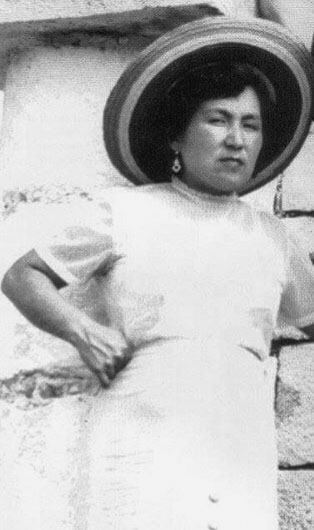
Hilda Gadea Acosta was a Peruvian economist, Communist leader, and author. She was the first wife of Che Guevara.
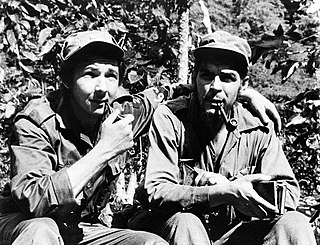
A guerilla foco is a small cadre of revolutionaries operating in a nation's countryside. This guerilla organization was popularized by Che Guevara in his book Guerilla Warfare, which was based on his experiences in the Cuban Revolution. Guevara would go on to argue that a foco was politically necessary for the success of a socialist revolution. Originally Guevara theorized that a foco was only useful in overthrowing personalistic military dictatorships and not liberal democratic capitalism where a peaceful overthrow was believed possible. Years later Guevara would revise his thesis and argue all nations in Latin America, including liberal democracies could be overthrown by a guerilla foco. Eventually the foco thesis would be that political conditions would not even need to be ripe for revolutions to be successful, since the sheer existence of a guerilla foco would create ripe conditions by itself. Guevara's theory of foco known as foquismo was self-described as the application of Marxism-Leninism to Latin American conditions, and would later be further popularized by author Régis Debray. The proposed necessity of a guerilla foco proved influential in Latin America, but was also heavily criticized by other socialists.

Ernesto "Che" Guevara was an Argentine Marxist revolutionary, physician, author, guerrilla leader, diplomat, and military theorist. A major figure of the Cuban Revolution, his stylized visage has become a ubiquitous countercultural symbol of rebellion and global insignia in popular culture.
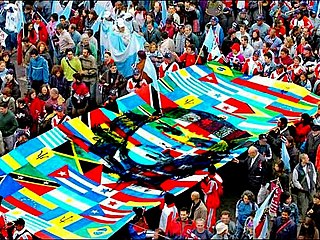
The legacy of Argentine Marxist revolutionary Che Guevara is constantly evolving in the collective imagination. As a symbol of counterculture worldwide, Guevara is one of the most recognizable and influential revolutionary figures of the twentieth century. However, during his life, and even more since his death, Che has elicited controversy and wildly divergent opinions on his personal character and actions. He has been both revered and reviled, being characterized as everything from a heroic defender of the poor, to a cold-hearted executioner.
Ernesto "Che" Guevara, was an Argentine Marxist revolutionary, politician, author, intellectual, physician, military theorist, and guerrilla leader. His life, legacy, and ideas have attracted a great deal of interest from historians, artists, film makers, musicians, and biographers. In reference to the abundance of material, Nobel Prize–winning author Gabriel García Márquez has declared that "it would take a thousand years and a million pages to write Che's biography."
Alexander Ivanovich Alexeyev was a Soviet intelligence agent who posed first as a journalist and later a diplomat. His arrival in Havana on 1 October 1959 inaugurated a new era in Cuba–Soviet Union relations. Alexeyev was later appointed as the Soviet Ambassador to Cuba, and played a vital role in easing tensions during the Cuban Missile Crisis.
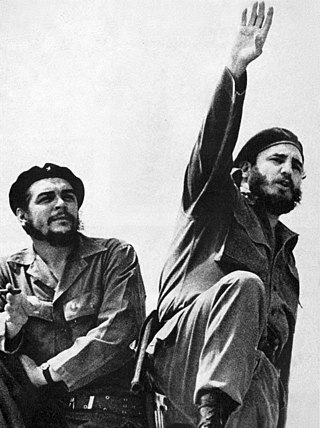
The consolidation of the Cuban Revolution is a period in Cuban history typically defined as starting in the aftermath of the revolution in 1959 and ending in the first congress of the Communist Party of Cuba 1975, which signified the final political solidifaction of the Cuban revolutionaries' new government. The period encompasses early domestic reforms, human rights violations continuing under the new regime, growing international tensions, and politically climaxed with the failure of the 1970 sugar harvest.
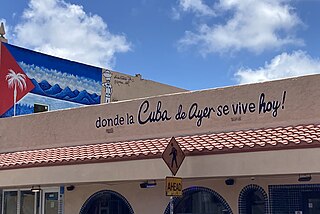
The idea of the Cuba de ayer is a mythologized idyllic view of Cuba before the overthrow of the Batista government in the Cuban Revolution. This idealized vision of pre-revolutionary Cuba typically reinforces the ideas that Cuba before 1959 was an elegant, sophisticated, and largely white country that was ruined by the government of Fidel Castro. The Cuban exiles who fled after 1959 are viewed as majorly white, and had no general desire to leave Cuba but did so to flee tyranny. Cuban exiles who uphold this image of the Cuba de ayer view their version of Cuban culture as more desirable than American culture, and that it is best to recreate their lost culture of the Cuba de ayer in the United States. Proponents of the image of the Cuba de ayer also view Cuba as a more worthy country to live in than the United States and hope to return Cuba to the Cuba de ayer after the hoped for fall of the government of Fidel Castro. Critics of the idea of the Cuba de ayer claim it is a nationalist myth created for white Cuban exiles that ignores the reality of Cuban life before 1959, and embraces an exotic vision of Cuba.
References
- 1 2 3 4 5 "A new book by Samuel Farber". Havana Times. 3 Dec 2011.
- ↑ "Obama and Latinos" (in Spanish). Brecha. 2012-11-30. Archived from the original on 2012-11-19.
- ↑ Sheyla Hirshon (2 Feb 2012). "Book review of Cuba: A Critical Assessment". Havana Times.
- ↑ Kapcia, Antoni (2014). "Samuel Farber, Cuba since the Revolution of 1959: A Critical Assessment. Chicago: Haymarket Books, 2011. Ix + 369 pp. (Paper US$24.00)". New West Indian Guide. 88 (3–4): 351–353. doi: 10.1163/22134360-08803026 .
- ↑ "The Politics of Che Guevara: A Review". 6 September 2016.